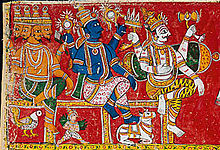Trimurti
![]()
The title of this article is ambiguous. For the film of the same name, see Trimurti (film).
![]()
This article or subsequent section is not sufficiently supported by evidence (e.g., anecdotal evidence). Information without sufficient evidence may be removed in the near future. Please help Wikipedia by researching the information and adding good supporting evidence.
Trimurti (Sanskrit त्रिमूर्ति Trimūrti; "three forms") is a concept of Hinduism that represents the union of the three cosmic functions of creation, preservation, and destruction or transformation, through the figuration of the great gods Brahma as the creator, Vishnu as the preserver, Shiva as the destroyer. The Trimurti symbolizes the origin of all divine effects in one unity, as the three aspects are mutually dependent and complementary; it represents the formless Brahman and expresses the creating, maintaining and destroying aspects of this supreme being.
.jpg)
Trimurti representation from Elephanta

Trimurti representation at the Hoysaleswara temple; Halebid

Trimurti paintings from Andhra Pradesh

Trimurti representation from the Ellora caves, from left to right: Brahma, Vishnu, Shiva
Meaning
The Trimurti is often explained by Indian philosophers from the three Gunas, the root causes of effects and activities:
- Tamas means ignorance, inertia, spiritual darkness and are assigned to Shiva who destroys them;
- Rajas, activity, passion and new beginnings, is associated with Brahma;
- Sattva means clarity, goodness and harmony and is associated with Vishnu.
The Gunas are assigned colors: black for Tamas, red for Rajas and white for Sattva. Likewise, the elements earth (Brahma), water (Vishnu) and fire (Shiva) are assigned to the Trimurti.
The Trimurti is the conceptual unity of the three-sided cosmic principle, similar to the Christian Trinity, and not a triad, i.e. three different deities belonging together, as known from most polytheistic mythologies. The Christian concept of the Trinity with God the Father, God the Son, and God the Holy Spirit differs in interpretation and religious philosophy from the Hindu one.
Tridevi
Shakti worshippers, the followers of the female represented form of God, also know a female Trimurti, called Tridevi, with Saraswati the creator, Lakshmi the preserver and Kali the destroyer.
Search within the encyclopedia